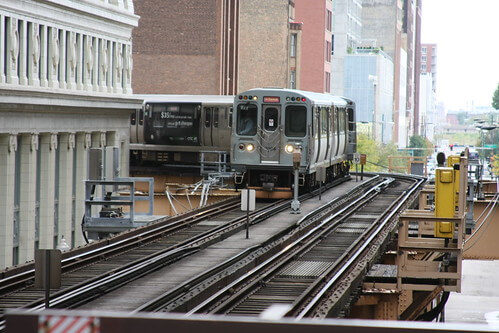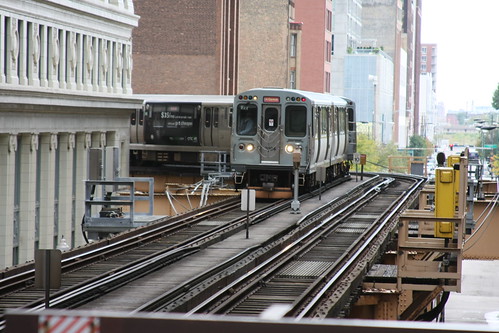
Traveling around Chicago and its surrounding areas can be daunting. If you have somewhere to be in the Windy City but you don’t want to worry about getting gas and finding a parking spot, you may want to consider using public transportation. With an extensive list of destinations and transportation options, you can always get where you need to be quickly and efficiently. But before you go, you might want to learn a little bit more about how to navigate this system. Read on for tips and information on how to use public transportation in Chicago from Pequod’s Pizza.
Using the Chicago Transit Authority (CTA)

Image via Flickr by ReneS Licensed CC BY 2.0
If you need to get anywhere in Chicago, chances are you can do it with the Chicago Transit Authority (CTA). This iconic system includes a mostly elevated public train rail, appropriately called the “L.” It also has bus routes to reach any destinations not covered by rail. Between these two offerings, the CTA effectively connects Chicago’s suburban neighborhoods with downtown, making it a great choice for commuters. On an average weekday, 1.6 million riders take some form of CTA. It’s no surprise, then, that this transportation system is the second-largest public transit system in the United States.
CTA’s Train Offerings
The CTA’s “L” system connects 145 stations within eight separate routes. While this dizzying number of options can seem insurmountable, a little preparation can help you successfully navigate this system. To start, the regular fare for a train is $2.50. You can also buy a one-day CTA pass for $5, a three-day pass for $15, or a seven-day pass for $20. There are reduced fares available for children, students, seniors, people with disabilities, and active military members.
To buy your ticket, you can go to a vending machine at each “L” station to purchase your single ride, one-day, or three-day pass with cash or credit card. If you’re planning on traveling frequently, you can get a Ventra Card, which you can load with value and easily swipe to get on your train. You can also add the Ventra Card app to your smartphone, giving you the option of virtually swiping your Ventra Card. You may wonder, “how can I find a train station near me?” The Ventra “train near me” feature can help locate the nearest ride.
Once you’ve swiped your ticket to enter the train station platform, the next step is to find your desired line and the direction you plan to travel. Depending on the station, there may be one line or multiple. Be sure to pay attention to make sure that you’re heading in the right direction. If you need to make a transfer, check one of the station’s maps to make sure you board the proper train. To eliminate any stress as the train arrives, you can always use the CTA’s trip planner to get personalized route information before you board.
When you’re confident that your train is in front of you, you can step on board and begin your ride. While you’re riding, make sure to pay attention so that you don’t miss your stop. This is especially important if you’re transferring. When you get to your destination, hop off the train, exit the station, and go about your day.
Navigating the Bus System
Just when you’ve become confident with the “L” system, you may need to take a CTA bus, offering a new navigation challenge. Luckily, the CTA’s bus system functions very similarly to the “L.” Although the bus system is larger with 140 routes available, you can easily figure it out with a little preparation.
A bus fare is $2.25, and its service is included along with the “L” in the CTA’s day and multiday passes. It also works the same in the Ventra system. If you’ve ever loaded your card to ride the “L” before, you’re already ready to go on the bus route.
Unlike the “L,” the bus route doesn’t include stations, so you’ll have to board on one of the system’s roadside stops. You can easily locate a bus stop by looking for the CTA signs. These signs can also give you information about the routes and destinations that the bus services. If you see your desired route, you can stand by the sign and wait for the next bus. Be sure to stand close to the sign so that the bus driver can see that you’re waiting.
When you board the bus, you can either pay your fare with your Ventra Card, CTA pass, or cash. Before you board, you might want to make sure you have the proper route. You can peruse the CTA’s lists of maps and guides to plan your trip. Once you’re confident that you’re heading in the right direction, you can enjoy your ride. Like with the “L,” make sure to pay attention to ensure that you don’t miss your stop. At the stop before yours, pull on the “stop request” wire to let the driver know that you intend to get off soon.
Metra Commuter Rail
If you’re looking to go farther out of the city, the Metra rail provides another service option. Servicing a large portion of northern Illinois, this system is a good option if you’d like to travel beyond the reach of the CTA’s trains and buses. Similar to CTA, you can purchase single-ride, weekend, 10-ride, or month passes. You can also buy your ticket after boarding the train or use your regular Ventra Card. To explore the Metra’s destinations and stops, check out their website for schedules, maps, and line information.
Tracking Your Ride
If you’re nervous about when your bus or train is coming or you simply want to plan your trip, you can use one of the CTA’s various tools to help you navigate. The CTA offers a CTA bus tracker and a train tracker that you can access online. You can also sign up for the CTA’s text alerts for updates on your specified routes and destinations. Using the Ventra app, you can also find information about if your desired line is running late. With the “train near me” feature, you can find a nearby station or line.
If you’re new to the Windy City or a Chicago traveler, the city’s extensive public transportation system can be challenging. But with this information, we hope you feel empowered to go anywhere you need to go. Whether you’re going to the airport, a game, or to our famous Pequod’s Pizza’s Chicago location, we want you to get there without stress or worry.